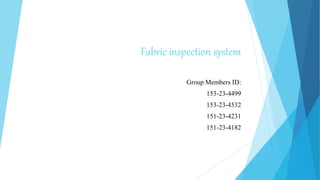
Fabric inspection system guide for apparel manufacturing
- 1. Fabric inspection system Group Members ID: 153-23-4499 153-23-4532 151-23-4231 151-23-4182
- 2. Introduction Inspection in reference to the apparel industry can be defined as the visual examination or review of raw materials partially finished components of the garments. It also examines completely finished garments by measuring the garments to check if they meet the required measurements, in relation to some requirements, standards or specifications. The main objective of inspection is the detection of the defects and nonconformance's as early as possible in the manufacturing process so that time and money are not wasted later on in either correcting the defect or writing off defective garments.
- 3. Inspection Loop Inspection Fault detection Overcome defect Inform appropriate person Cause of defect
- 4. Types of inspection system The various fabric inspection systems used in the garments industry are given here: Four-point system Ten-point system Graniteville “78” system Dallas system.
- 5. 4 point system In this system fabric faults are identified with defect points in the scale of 4. i.e. maximum defect points is 4. According to this system, if the total defect parts per 100 yards of fabric are 40 or more, the fabric will be rejected. Criteria for giving penalty points: Length of Defect Penalty point Up to 3 inch 1 Over 3 inch - up to 6 inch 2 Over 6 inch - up to 9 inch 3 Over 9 inch 4 1 inch or less (Holes) 2 Over 1 inch 1
- 6. Some general rules for 4 point system Not one meter of cloth is penalized more than 4 point. Any defect occurring repeatedly through out the entire piece is marked second. [Second is a cloth quality which implies that the cloth contains minor defects. A trade discount of 8-15 is allowed in this category.] Cloth is inspected on face side only unless specified.
- 7. Fabric inspection grades Basic principle: Defect point values should be counted in 100yds fabric. If defect point values are 40 or less then it indicates first quality fabric. The grading range is given below: Point Grade ≤ 40 A Above 40 - 60 B Above 60 - 80 C Above 80 REJECTED
- 8. Calculation:
- 9. 10 point system In this system, the fabric fault are identified with points on the basis of the scale of 10, i.e. the maximum defect point is 10. According to this system, If the total defect points per 100 yards of fabric are 100 or more the fabric will be rejected. In this system warp & weft direction faults are separately inspected and assigned defect points.
- 10. Defect point Chart Warp defect Penalty points Up to 1” 1 points From 1” to 5” 3 points From 5” to 10” 5 points From 10” to 36” 10 points Weft defect Penalty points Up to 1” 1 points From 1” to 5” 3 points From 5” to full width 5 points Full width 10 points
- 11. Some general rules for 10 points Not one meter of cloth is penalized more than 10 points. Any defect occurring repeatedly throughout the entire piece is marked second. Combination of warp and weft defect running is one meter should not be penalized more than 10 points in the meter. Cloth is inspected on face side only unless specified.
- 12. Advantages of 10 point system: Oldest and most used in woven finished fabric. In it length of fabric is used and along the length of warp and weft defects are identified. Disadvantages of 10 point system: It has width limitation. It is difficult in practical use
- 13. Graniteville “78” system This system was basically established for garment cutting components, in which the short length faults less than 9″ would normally be removed. The system aims to balance the significance of longer defects (over 9″) and place less weight on 1–10″ faults such as slubs. The system recommends the viewing distance of 9′ instead of the normal 3′ distance. Assignment of Points in Graniteville “78” System: Defect Length Penalty Points 9″ 1 9–18″ 2 18–27″ 3 27–36″ 4
- 14. Dallas system The Dallas system was introduced in the 1970s and it was developed particularly for knitted fabrics. According to this inspection method, if any fault was observed on a finished garment, then the garment would be called ‘seconds’. It describes the seconds as ‘more than one defect per ten linear yards, determined to the nearest ten yards’. For example, one piece 60 yards long would be allowed to have six defects. Disadvantage of Dallas system: It increases the cost of production as defect is located after the garment is finished.
- 15. Types of defects found in fabric Some fabric defects are given below: Major woven fabric defects Slubs, hole, missing yarn, conspicuous yarn variation, end out, soiled yarn, wrong yarn. Major knitted fabric defects Mixed yarn, yarn variation, runner, needle line, barre, slub, hole, and press off. Major dye or printing defects Out of register, dye spots, machine stop, color out, color smear, or Shading.
- 16. Types of products inspection: 1. Pre-production / Initial production inspection. 2. During Production inspection. 3. Final random inspections / Pre-shipment inspection. 4. Container loading inspection.
- 17. Conclusion It is the responsibility of both the textile supplier and garment manufacturer to inspect all textiles to ensure their compliance with the buyer standard. Textile which are being exported to another country for use in the assembly of a finished product are required to be inspected by the buyer’s designed inspection service prior to shipment.